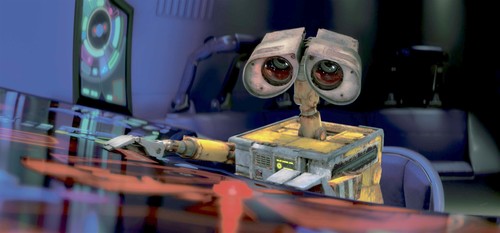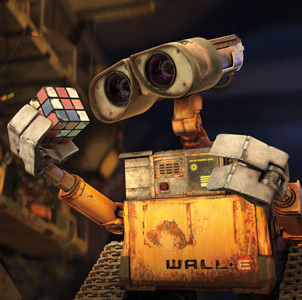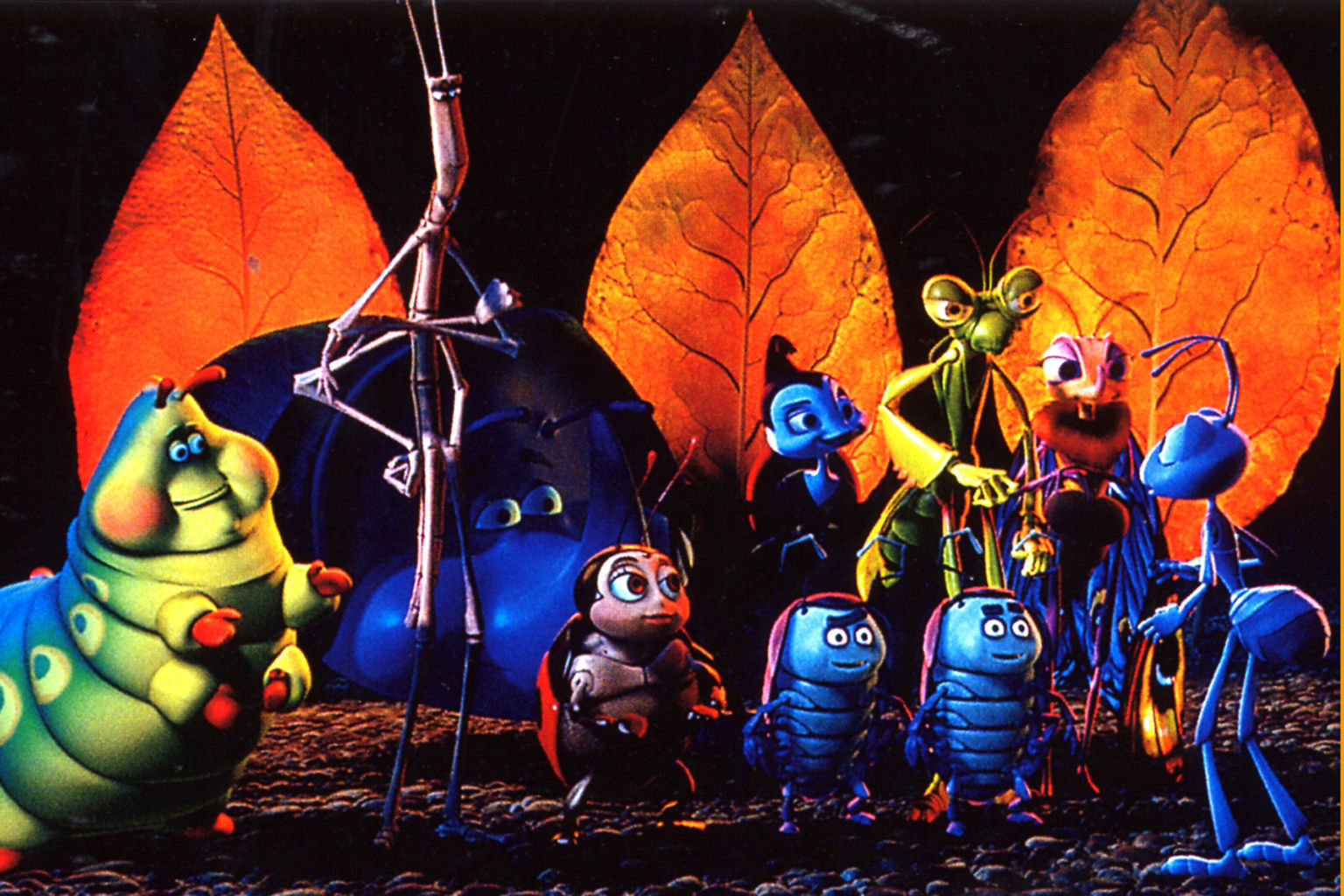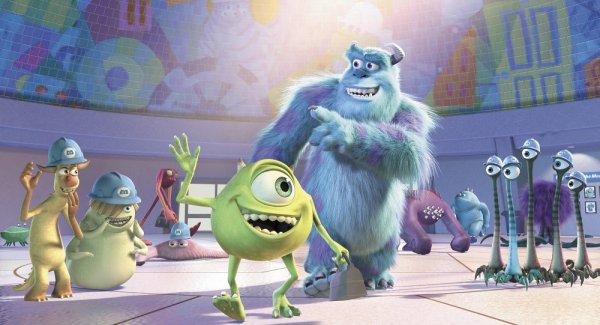
9 X 9: When Andrew Stanton first joined Pixar he was only the fledgling company’s ninth employee. Now, 18 years on, Stanton has delivered us Pixar’s ninth movie, WALL•E (Short for: Waste Allocation Load Lifter•Earth-Class.) Not so surprisingly, given Pixar’s track record, WALL•E is already being hailed as another animation “masterpiece.”
Below the fold are some of Andrew Stanton’s thoughts on the film (provided by Disney’s head of communications, Howard E. Green), which I have combined with an interview I conducted with Stanton at the time MONSTERS, INC. was first released.
QUESTION: The original idea for WALL•E came about at a Pixar lunch meeting way back in 1994, before TOY STORY was even released. What was the concept like then?
ANDREW STANTON: One of the things I remember coming out of (the meeting) was the idea of a little robot left on Earth. We had no story. It was sort of this Robinson Crusoe kind of little character—like, what if mankind had to leave Earth and somebody forgot to turn the last robot off, and he didn’t know he could stop doing what he’s doing? I started to just think of him doing his job every day and compacting trash that was left on Earth and it just really got me thinking about what if the most human thing left in the universe was a machine? That really was the spark. It has had a long journey. I then became fascinated with the loneliness that this situation evoked and the immediate empathy that you had for this character. We spend most of our time on films trying to make our main characters likeable so that you want to follow them and root for them. I started thinking, ‘Well, where do I go with a character like this?’ And it didn’t take long to realize that the opposite of loneliness is love or being with somebody. I was immediately hooked and seduced by the idea of a machine falling in love with another machine. And especially with the backdrop of a universe that has lost the understanding of the point of living. To me, that seemed so poetic. I loved the idea of humanity getting a second chance because of this one little guy who falls in love. I’m a hopeless romantic in cynic’s clothing. This movie gave me a chance to indulge in that romantic side a little more than I normally would in public.
QUESTION: The first half of the movie is completely without dialogue.
ANDREW STANTON: We felt we could do it with non-traditional dialogue, maintaining the integrity of the character. In real life, when characters can’t speak—a baby or a pet—people tend to infer their own emotional beliefs onto them: ‘I think it’s sad,’ ‘She likes me.’ It’s very engaging for an audience. We also wanted the audience to believe they were witnessing a machine that has come to life. The more they believe it’s a machine, the more appealing the story becomes.
QUESTION:The animators must have loved working on the film.
 ANDREW STANTON: Yes, in the world of animation, pantomime is the thing that animators love best. It’s their bread and butter; they’re raised on it instinctually. John Lasseter realized this when he animated and directed his first short for Pixar, LUXO, JR. featuring two lamp characters who express themselves entirely without dialogue. The desire to give life to an inanimate object is innate in animators. For all the animators on WALL•E, it was like taking the handcuffs off and letting them run free. They were able to let the visuals tell most of the story. They also discovered that it’s a lot more difficult to achieve all the things they needed to. So I kept trying to make the animators put limitations on themselves, because I wanted the construction of the machines and how they were engineered to be evident. The characters seem robotic because they don’t squash and stretch. It was a real brain tease for the animators to figure out how to get the same kind of ideas communicated and timed the way it would sell from a storytelling standpoint and yet still feel like the machine was acting within the limitations of its design and construction. It was very challenging—and completely satisfying when somebody found the right approach and solution.
ANDREW STANTON: Yes, in the world of animation, pantomime is the thing that animators love best. It’s their bread and butter; they’re raised on it instinctually. John Lasseter realized this when he animated and directed his first short for Pixar, LUXO, JR. featuring two lamp characters who express themselves entirely without dialogue. The desire to give life to an inanimate object is innate in animators. For all the animators on WALL•E, it was like taking the handcuffs off and letting them run free. They were able to let the visuals tell most of the story. They also discovered that it’s a lot more difficult to achieve all the things they needed to. So I kept trying to make the animators put limitations on themselves, because I wanted the construction of the machines and how they were engineered to be evident. The characters seem robotic because they don’t squash and stretch. It was a real brain tease for the animators to figure out how to get the same kind of ideas communicated and timed the way it would sell from a storytelling standpoint and yet still feel like the machine was acting within the limitations of its design and construction. It was very challenging—and completely satisfying when somebody found the right approach and solution.
LAWRENCE FRENCH: It’s also interesting that in MONSTERS, INC. you decided not to have Boo, the little girl, speak.
ANDREW STANTON: Yes, Boo’s age was debated for quite awhile and there was a faction of us that right away saw the appeal of having a child that was not speaking words yet. That would allow for an even easier leap for the audience to see that she is seen as a pet first, and not as a person. Also, I think one reason people have such fondness for their pets, is that they don’t know the specifics of how that animal feels, so they can project how much that animal loves them, and it’s always going to be more powerful than if everything was spelled out for them. Having a kid that can just speak goobly-gook, allows the same thing for the audience and the characters in the movie. Before the power of that became obvious to certain people, we really had to record Mary Gibbs and put some of her “voice” into the movie. Nobody was saying, “No you can’t do that,” they just wondered if it would work.
LAWRENCE FRENCH: It would appear WALL•E will almost certainly be nominated for “Best Animated Film” this year, but probably not for “Best Picture.”
ANDREW STANTON: While it’s nice that animated films have their own category, my feeling is now we’re forever resigned to the kid’s table. No matter how good you make the movie nobody is going to say, “it holds up against any other great movie.” I don’t want to look a gift horse in the mouth, it’s great for the acknowledgment, but we don’t think of it as a separate medium as strongly as other people do. When we’re in the thick of it, we’re trying to make the best damn movie we can. We’re not thinking, “it’s only animated, so we only have to do it like this.” Nobody ever thinks like that. We’re thinking, “is this is as good as I want the movie to be?” Just like THE GODFATHER, CITIZEN KANE, STAR WARS, 2001, or whatever other great movie you care to name. So it’s kind of frustrating that no matter how hard you work, it comes out and – boom! – you’re still at the kids table. But we still love it, so that’s never going to stop us from wanting to work in the animation medium.
LAWRENCE FRENCH: It’s strange how mainstream Hollywood movies, particularly mindless summer movies, seem to be getting more and more juvenile, while Pixar’s animated films are taking “kids films” to another level by making them more adult-oriented.
ANDREW STANTON: Yes, isn’t that weird? There is plenty of room for good movies, and especially good family movies. I think the hardest movie to make is one that an 8-year old, an 18-year old, and an 80-year old person can go to see and enjoy. I’m more impressed with a comedian who can get all the laughs, and get the best laughs, without having to swear. It’s not that I’m a purist, but why exclude people if you don’t have to? And just because of it’s nature, animation will always draw young audiences. So you don’t have to work too hard in that area, you just want to make sure you don’t exclude children and then work harder trying to see if you can get everybody who’s still a kid inside to watch the movie. You have to have a showman part of you, just to want to make these movies, so why wouldn’t you want the biggest audience possible?
LAWRENCE FRENCH: After co-writing Pixar’s first three films, you ended up co-writing MONSTERS, INC. and have now become Pixar’s star screenwriter.
ANDREW STANTON: Well, they keep giving me the job, so I can’t be screwing up that badly. Early on I was more involved as an Executive Producer on MONSTERS, INC. than as a writer, because Pete Docter and Jeff Pidgeon came up with the idea for the movie right around the time A BUG’S LIFE was kicking into high gear. So I came in and helped out Pete with his first movie, giving advice, and sort of playing the objective party. It wasn’t until about a year and a half into MONSTERS, INC. when they were having trouble getting it off the ground, developing it, and I was nearing the end of work on A BUG’S LIFE, that I began writing on it. Actually, as busy I was in post, you still spent a lot of time sitting around waiting for things to be done. Like waiting for the sound design, or for the color timing, and so when it when it came up that they were having a frustrating time trying to get MONSTERS, INC. into shape, and their was a lot of strong opinions about where it should go and who we wanted to do it, they said to me, “would you be willing to do it?” I think they expected the answer to be no, but I though about it and I said, “Within this time frame I could give it a shot.”
I actually enjoyed it, because I find the back end of a movie really only needs your physical presence, but the part of you that’s always thinking up ideas is kind of shut off. So I was kind of raring to go. I was actually over at Skywalker sound for weeks doing the sound mix on A BUG’S LIFE and they found this little room for me to work in, right upstairs next to the projector, so there was this big loud projection noise, and I was in the room next door typing away, coming up with scenes. It was kind of nice, because I don’t usually get a concentrated three or four weeks like that, of just being able to just focus on one thing. I’m sure most writers get that, but it was a real luxury for me. It really allowed me to give most of the foundation to what MONSTERS, INC. became. And once I had that, I knew it would evolve even further, because everything we do here evolves, so I never expected it to be the be all, or the end all. I’ve never written anything that I felt was that, and Dan Gerson was the guy who came in after I left and keep running with it. I felt really good with what I came up with. I named the little girl, Boo, and developed Sulley and Mike’s relationship, and worked with the way the MONSTERS, INC. world worked—the whole idea of children’s screams powering the Monster world and the whole caper aspect of it. In the Himalayas, with the Yeti, those were all fundamental ideas that weren’t there, that I had fun bringing to it. Then I spent the rest of my time playing executive producer for the back half of it. Because we had TOY STORY 2 going, and I was about to start work on FINDING NEMO.
LAWRENCE FRENCH: One thing that has become a trademark of Pixar films, is the careful analysis you give to the story. You’re dealing with fantasy worlds, but you always seem to give those worlds a strong foundation in logic.
ANDREW STANTON: Part of that is because we have the time to get it right; it takes us years to make a movie. But also, a lot of that I learned from John (Lasseter). It really bug’s him when something doesn’t make sense. Not so much that you have to have logic, just for logic’s sake, but more that he doesn’t like the opposite, he doesn’t like to be thrown out of a movie because something doesn’t make sense. All John wants is to be caught up in that movie for 90 minutes, and for John logic plays a huge role in whether or not you’re going to be in or out of the movie. Sometimes logic can be your worst enemy, if you’re spending so much time trying to explain something. A lot of times, we will throw out a whole idea, just so you’re not thinking about the logic, because we certainly know the holes in our films, even if nobody else does. The big driving thing though, is if you can make it work, wouldn’t that help? Especially when you get into fantasy.
So there was a much tougher role for logic when we did A BUG’S LIFE, that compounded when we went into MONSTERS, INC. I think the more you go into magic, or made-up worlds, you have to have rules, or else anything can happen. You have to adhere to them, and structure them in a way that are very clear in the movie. So once we came up with the reason why the monsters scare kids — because they need their screams, and that’s their fossil fuel, then it became fun to figure out the way they would go about doing that, and how it would all work. And that all shows in the factory, down to the minutest details — how everything is put there, and how their day would run. It gives them that kind of Flintstone world, where part of the entertainment is seeing how the world actually works. We wouldn’t take every movie to the same degree we do in MONSTERS, INC., but I think this film really called for it. It’s part of the appeal. In their apartments they have double doors, one smaller door, within the bigger door, so if you’re a smaller monster you can adjust. So logic is a big thing with us.


Ah who died and made pixar god? I think I want to go on strike and skip WALL E and everything else. Was everone ay Disney who desended from the Fantasia school of animation fired? Ya their has been quality and some good stories but I am not looking at Shrek as the clever one now since this round super bubbly and accurate world of cgi has left The Simpsons movie in 2d as the farewell to anything done by hand. I think not. Id rather see Beavis and But Head then the new Star Wars thing, and pixar needs to quit being such ani-hogz